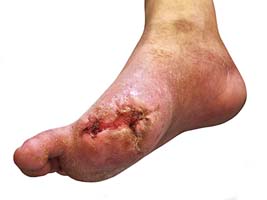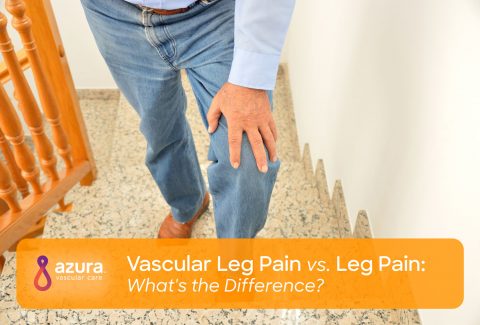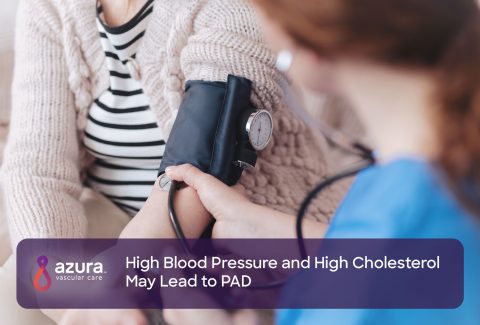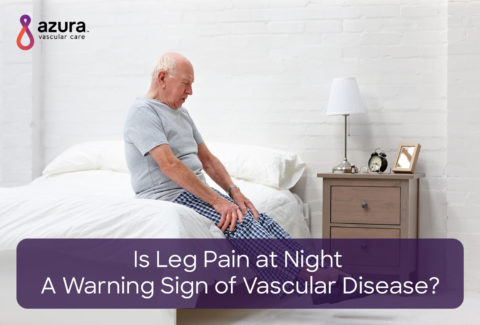
PAD is a serious medical condition that involves blockage of the arteries in the legs. These blockages, consisting of cholesterol and plaque, limit the blood flow, which carries oxygen and nutrients, to the lower parts of the leg.
PAD can cause pain and foot ulcers, and, for those living with diabetes, may be a contributing factor in developing a non-healing diabetic foot ulcer. Diabetic foot ulcers are the leading cause of amputation due to diabetes.[ii]
Do you think you or someone you know may be at risk for Peripheral Artery Disease and possibly among the estimated 8.5 million people in the United States with peripheral artery disease (PAD)?[i]
Keep reading to learn more on PAD risk factors and to make you aware of symptoms of PAD.
8 Risk Factors for Peripheral Artery Disease
There are multiple risk factors that increase the chances of being at risk for Peripheral Artery Disease, but they are not all equal. PAD risk factors may include the following:
1. Your age – Almost 15% of adults over the age of 70 have PAD.[iii] However, being younger than 70 does not mean that you are safe; it’s not uncommon for people in their 50’s to be diagnosed with PAD.[iv]
 2. You have diabetes – Having diabetes significantly increases your risk of PAD by 1.8 to 4 times.[iv] The longer you have had diabetes the greater your risk of developing PAD is.
2. You have diabetes – Having diabetes significantly increases your risk of PAD by 1.8 to 4 times.[iv] The longer you have had diabetes the greater your risk of developing PAD is.
3. You smoke – Smoking is one of the strongest risk factors for developing PAD. If you are a smoker, you’re between 2 and 4 times more likely to have PAD than a non-smoker.[iv]
4. You have high blood pressure, or your doctor tells you that you need blood pressure medication – Having high blood pressure, particularly if it’s not well-controlled, increases your risk for the development of PAD.
5. Your cholesterol is high – You are at risk for PAD if your total cholesterol numbers are high.
6. Your race – African Americans are twice as likely to have PAD.[iv]
7. You are on dialysis – Having kidneys that do not function properly is a risk factor for PAD; between 15 and 23% of people on dialysis will have PAD.[v]
8. PAD runs in your family – If you have multiple family members with peripheral artery disease, you are almost twice as likely to develop PAD as someone without a family history. This risk is even higher if PAD develops in your family members when they are younger than 68.[vi] If other vascular disease runs in your family, such as heart attack or stroke, you are also at increased risk.
Common Symptoms of PAD
If you think you are at risk for Peripheral Artery Disease, the next step is to become familiar with some specific symptoms that may indicate you have PAD, including some of the following:
 Pain in the legs at when at rest
Pain in the legs at when at rest- Fatigue or pain in the legs that comes on with walking but gets better with rest
- One leg that is colder to the touch than the other leg
- An ulcer, or wound, on the foot or leg that is not healing
- Toenails that do not grow
- Little to no leg hair
- Pale or blue color to your toes, feet or legs
RELATED: 4 Reasons You Need See a Doctor if You Are At Risk for PAD
Why You Should Know if You Are At Risk for PAD?
PAD is a condition you need to take seriously. If you don’t take steps to address your PAD through medication or other treatments, the blockages may worsen. Early diagnosis of PAD allows you to:
- Have better treatment options – You will have more options for PAD treatment early on in the disease, such as minimally invasive procedures, which includes lifestyle changes, angioplasty, stenting and atherectomy. The longer you wait the more likely it is that you will require more invasive surgical procedures, including bypass and amputation.
- Avoid complications – Untreated PAD can lead to tissue death, or gangrene. This may occur gradually, or a clot can form in an already-compromised blood vessel causing critical limb ischemia. Critical limb ischemia is a medical emergency because if the blood flow is not immediately restored, the tissues that are affected will die. Amputation is the most likely outcome if PAD is left untreated
- Lessen the risk for a heart attack or stroke – Having PAD means you have an increased risk for heart disease or a stroke. The good news is that the medical treatments for PAD can help lessen this risk.[vii]
- Finally quit smoking – Of the risk factors described above, smoking is the one factor that you have the complete power to control. Now is the time to quit smoking.
Are you at risk for PAD? Did you have any of the PAD risk factors or symptoms above? If you suspect you are at risk or if you are experiencing symptoms of PAD now, please make an appointment with your doctor to discuss your symptoms and history and to develop a plan for your next steps.
Sources:
[i] Selvin, E., Erlinger, T.P., Prevalence of and Risk Factors for Peripheral Arterial Disease in the United States Results from the National health and nutrition Examination Survey, 1999-2000. Circulation, 2004, 110: p. 738-743. http://circ.ahajournals.org/content/110/6/738.full (accessed 8/18/2016)
[ii] Brownrigg, J.R.W., Apelqvist, J., Bakker, K., Schaper, N.C., and Hinchliffe, R.J., Evidence-based managed of PAD & the Diabetic Foot. Euro J Vasc and Endovasular Surg, 2013. 45(6): p. 673-681. http://www.ejves.com/article/S1078-5884(13)00136-6/abstract (accessed 7/30/2016)
[iii] Allison, M.A., Ho, E., Denenberg, J.O., Langer, R.D., Newman, A.B., Fabsitz, R.R., Criqui, M.H., Ethinic-specific prevalence of peripheral arterial disease in the United States. Am J Prev Med, 2007, 32(4): pp. 328-33. http://www.ncbi.nlm.nih.gov/pubmed/17383564 (accessed 8/18/2016)
[iv] Criqui, M.H., Aboyans, V., Epidemiology of Peripheral Artery Disease, Circ Res, 2015, 116: p. 1509-1526. http://circres.ahajournals.org/content/116/9/1509.long (accessed 8/18/2016)
[v] O’Hare, A., Johansen, K., Lower-extremity peripheral arterial disease among patients with end-stage renal disease, J Am Soc Nephrol, 2001, 12(12): pp. 2838-47 http://jasn.asnjournals.org/content/12/12/2838.long (accessed 8/20/2016)
[vi] Kullo, I.J., Leeper, N.J., The Genetic Basis of Peripheral Arterial Disease Current Knowledge, Challenges, and Future Directions, Circ Res, 2015, 116: pp. 1551-1560. (accessed 8/18/2016)
[vii] Centers for Disease Control and Prevention. Peripheral Arterial Disease in the Legs Fact Sheet. http://www.cdc.gov/dhdsp/data_statistics/fact_sheets/docs/fs_pad.pdf (accessed 8/18/2016)


